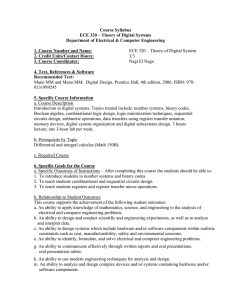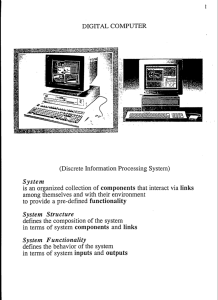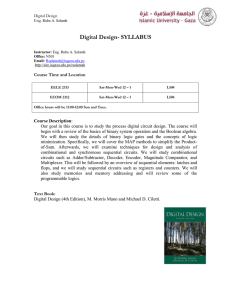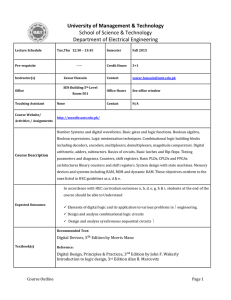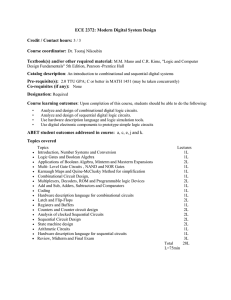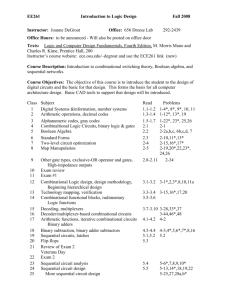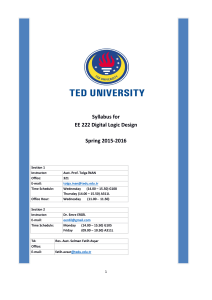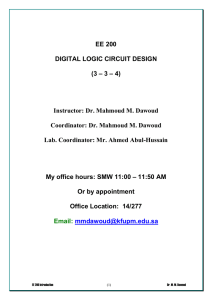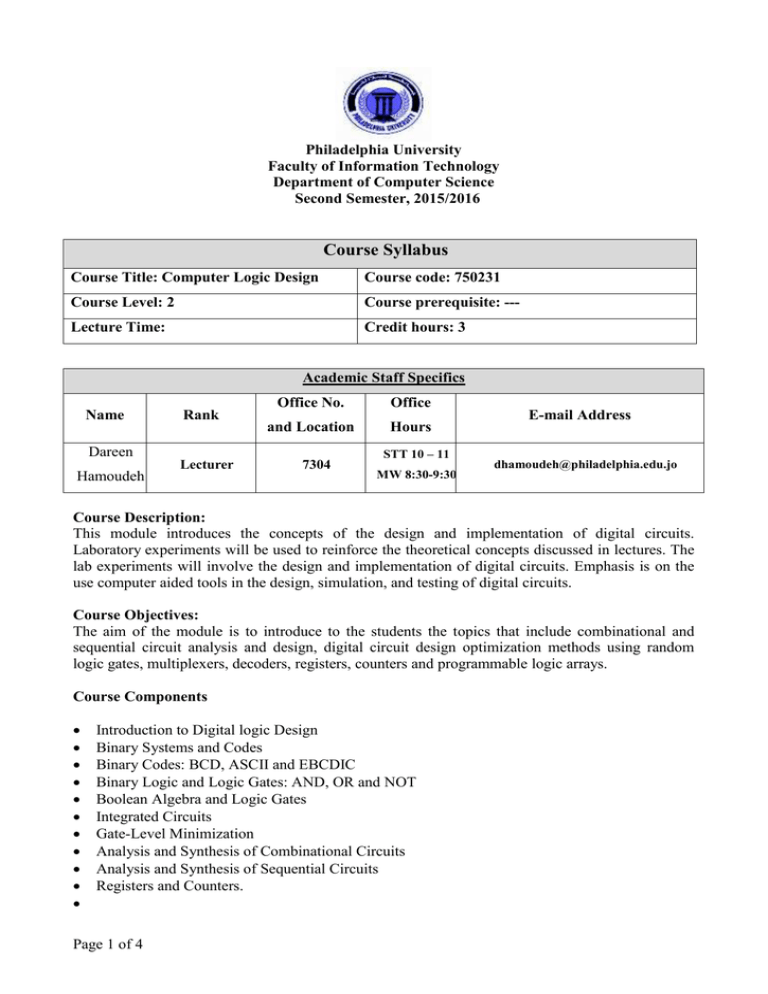
Philadelphia University
Faculty of Information Technology
Department of Computer Science
Second Semester, 2015/2016
Course Syllabus
Course Title: Computer Logic Design
Course code: 750231
Course Level: 2
Course prerequisite: ---
Lecture Time:
Credit hours: 3
Academic Staff Specifics
Name
Rank
Office No.
Office
and Location
Hours
Dareen
Hamoudeh
Lecturer
7304
STT 10 – 11
MW 8:30-9:30
E-mail Address
dhamoudeh@philadelphia.edu.jo
Course Description:
This module introduces the concepts of the design and implementation of digital circuits.
Laboratory experiments will be used to reinforce the theoretical concepts discussed in lectures. The
lab experiments will involve the design and implementation of digital circuits. Emphasis is on the
use computer aided tools in the design, simulation, and testing of digital circuits.
Course Objectives:
The aim of the module is to introduce to the students the topics that include combinational and
sequential circuit analysis and design, digital circuit design optimization methods using random
logic gates, multiplexers, decoders, registers, counters and programmable logic arrays.
Course Components
Introduction to Digital logic Design
Binary Systems and Codes
Binary Codes: BCD, ASCII and EBCDIC
Binary Logic and Logic Gates: AND, OR and NOT
Boolean Algebra and Logic Gates
Integrated Circuits
Gate-Level Minimization
Analysis and Synthesis of Combinational Circuits
Analysis and Synthesis of Sequential Circuits
Registers and Counters.
Page 1 of 4
Textbook:
Title: Digital Logic
Author: Morris Mano
Publisher: Prentice Hall, 2012
In addition to the above, the students will be provided with handouts by the lecturer.
Teaching Methods:
Duration: 16 weeks, 48 hours in total
Lectures: 41 hours (2-3 per week)
Tutorial: 4 hours (1 every 3 weeks)
Learning Outcomes:
A- Knowledge and understanding
A2. Know & understand a wide range of principles and tools available to Minimize functions
using any type of minimizing algorithms (Boolean algebra, Karnaugh map the software
developer, such as design methodologies, choice of algorithm, language, software libraries and
user interface technique:
A4. Know & understand a wide range of hardware used in development of computer systems
A5. Know & understand the professional and ethical responsibilities of the practicing computer
professional including understanding the need for quality.
B- Intellectual skills (thinking and analysis).
B1. Analyze a wide range of problems and provide solutions through suitable algorithms, structures,
diagrams, and other appropriate methods
B4. Practice self learning by using the e-courses
C- Practical skills
C3. Work effectively with and for others.
C4. Strike the balance between self-reliance and seeking help when necessary in new situations
C5. Display personal responsibility by working to multiple deadlines in complex activities
D- Transferable Skills
D2. Prepare and deliver coherent and structured verbal and written technical reports.
D4. Use the scientific literature effectively and make discriminating use of Web resources
D5. Design, write, and debug computer programs in appropriate languages
Learning outcomes achievement
Development: A2, A4, and A5 are developed through the lectures and laboratory sessions.
B1, D5, C3, and C4 are developed trough Tutorials and Lab sessions,
B4, D2, D4, D5, and C5 are developed through Homework
Assessment : A2, A4, A5, B1, D5, and C4 and are assessed through Quizzes, written
exams, and Practical Works Exams.
B4, D2, D4, D5, and C5 are assessed through Homework Exam.
Page 2 of 4
Assessment Instruments
Allocation of Marks
Assessment Instruments
First examination
Second examination
Final Exam
Three Quizzes and Home works.
Total
Mark
20%
20%
40%
20%
100%
* Make-up exams will be offered for valid reasons only with consent of the Dean. Make-up exams
may be different from regular exams in content and format.
Practical Submissions:
The assignments that have work to be assessed will be given to the students in separate documents
including the due date and appropriate reading material.
Course Academic Calendar:
Basic and support material to be covered
Week
(1)
(2)
(3)
(4 & 5)
(6 & 7)
First Exam
(8& 9)
Page 3 of 4
Digital Computers and digital systems
Binary Numbers.
Number based conversion.
Octal and Hexadecimal Numbers.
Signed Binary Numbers
Complements.
Arithmetic Operations (Add and Subtract).
Logic Gates
NOT, AND, OR, NAND, NOR, Exclusive-OR and Equivalence.
Logic Circuits.
Boolean Algebra.
Basic Definition.
Basic Theorems.
Boolean Functions.
Canonical Forms: Minterms & Maxterms.
Simplification using SOP and POS.
Simplification Using Map Method
Two- and Three- Variables Maps.
Four-Variable Map.
NAND and NOR Implementation.
Don't Care conditions.
Combinational Logic Circuits
Adders and Sub tractors.
Multilevel NAND.
Multilevel NOR.
(10 & 11)
(12 & 13)
Second Exam
(14)
(15)
(16)
Final Exam
Combinational Logic Circuit with MSI and LSI
Binary Adders.
Binary Sub-tractor.
Decoders.
Multiplexers.
Sequential Circuits
Flip-Flops.
Analysis of Clocked Sequential Circuits.
Flip-Flops: RS, D, JK and T.
Flip-Flop Excitation Tables.
Design Procedure
Example of Sequential Circuit.
Registers and Counters
Review
Expected Workload:
On average students need to spend 2 hours of study and preparation for each 50-minute
lecture/tutorial.
Attendance Policy:
Absence from lectures and/or tutorials shall not exceed 15%. Students who exceed the 15% limit
without a medical or emergency excuse acceptable to and approved by the Dean of the relevant
college/faculty shall not be allowed to take the final examination and shall receive a mark of zero
for the course. If the excuse is approved by the Dean, the student shall be considered to have
withdrawn from the course.
Module References
Students will be expected to give the same attention to these references as given to the Module
textbook(s)
1. Morris Mano, Charles R. Kime, Logic and computer design fundamentals, Pearson Prentice
Hall, 2004.
2. Basavaraj,B., Digital fundamentals, New Delhi: Vikas Publishing House, 1999.
3. Kandel Langholz, Digital Logic Design, Prentice Hall, 1988.
.
4. Rafiquzzaman & Chandra, Modern Computer Architecture, West Pub. Comp., 1988.
Website(s):
-
https://www.cs.utexas.edu/~byoung/cs429/slides5-logic.pdf
-
https://en.wikiversity.org/wiki/Computer_Logic#Addition
-
http://american.cs.ucdavis.edu/academic/ecs154a.sum14/postscript/cosc205.pdf
Page 4 of 4

